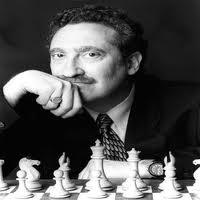
Pandolfini's Puzzler #40 - The Art of Beautiful Chess Talk
Professor: Hello, class. I see we’ve doubled in size. Allow me to introduce two new classmates.
Zephyr and Lucian: Two new classmates?
Professor: Zephyr and Lucian, please meet Hale and Ryan.
Zephyr and Lucian: Hello.
Hale and Ryan: Hi.
Professor: Lucian, I hope you and Zephyr enjoyed that bughouse game the two of you played last week.
Lucian: Well, let’s just say it was a creative experience.
Zephyr: Yeah, we each played two boards and split two games.

Professor: Anyhow, it’s certainly great to see all your smiling faces. It creates a beautiful picture.
Lucian: I’d rather create a beautiful chess position.
Hale: And what makes a chess position beautiful?
Zephyr: What makes anything beautiful?
Ryan: Or artful?

Lucian: Maybe patterns and economy; maybe surprise.
Ryan: Didn’t James Joyce talk about art and beauty in his novel A Portrait of the Artist as a Young Man?
Zephyr: Yes he did. I think his main character, Stephen Dedalus, discusses principles of art with Lynch, a fellow student.
Lucian: I read that book.
Hale: Who hasn’t?
Their smiles were getting smilier.
Ryan: Naturally, I prefer Dylan Thomas’ Portrait of the Artist as a Young Dog.
Lucian: Dogs can be beautiful.
Zephyr: I like dogs. I even have one. His name is Cecil.

Hale: With deference to Cecil, I don’t think Joyce got his ideas from a dog, even a beautiful one.
Ryan: I think he got them from Thomas Aquinas.
Lucian: That 13th century ecclesiastic and thinker?
Hale: Didn’t Aquinas say that art should have integritas, consonantia, and claritas?
Lucian: Hey, why the Latin? Let’s stick with English.
Hale: OK. In translation, a work of art has to show wholeness, harmony and radiance.
Professor: Actually, lots of people have written about the principles of art, in various languages.
Lucian: Wholly, harmoniously or radiantly, in any language, why do we have to cite Aquinas, Joyce, or Dylan Thomas?
Hale: We don’t! We can bring up Vladimir Nabokov. Not only was he a literary aesthete, he also composed nice chess problems.

Ryan: He did, but why not defer to a greater chess authority, Pal Benko? He’s a true artist by any standards.
Lucian: No kidding. In his book Pal Benko: My Life, Games and Compositions, Benko essentially says that an artful chess problem should be thematic, original, and sound.
Zephyr: Didn’t he also write that an artistic chess composition should express economy?
Ryan: Yes, and he said something else, too – that it adds to a problem’s art if answer variations are conceptually related and reasonably difficult to find.
Lucian: So those are the things thatmake a chess composition beautiful. But wait, isn’t beauty in the eyes of the beholder?
Ryan: Yes and no. There has to be an objective basis to artistic evaluation.
Zephyr: But usually there’s also a subjective one. After all, people like what they like.
Professor: Woah! Let’s slow down here. I’m extremely pleased with what I’m hearing. Objectively and subjectively, however, it’s time for less talk and more chess.
Lucian: Thank you, Professor.
Professor: Don’t thank me yet. I haven’t shown you the first position.
Lucian: I can’t wait.
Zephyr: I can.

Professor: One difficulty with chess composition is an unforeseen alternative answer.
Ryan: You mean when there’s an unexpected answer the composer didn’t see?
Professor: Yes, that’s what I mean.
Lucian: Those are called cooks, right?
Professor: Yes again.
Zephyr: A cook tends to lower the artistic worth of a problem.
Professor: That’s normally true. But suppose the composer creates a problem with multiple solutions on purpose.
Lucian: That would be a different ballgame.
Ryan: And a different work of art.
Hale: What do you mean exactly, Professor?
Professor: Well, consider our first position.
Question 1: How can White mate in two moves?
Professor: There’s a lot to this position. Not only can White mate in two moves, but the composer, N. Zinovyev, has given us four different answers.
Ryan: Four different acceptable mates in two moves?
Lucian: That makes it easier to be right.
Hale: And harder to be wrong.
Professor: So find all four answers. Then pick out the most appealing solution.
Zephyr: I get it. You want us to solve it and say what we like, if anything.
Professor: That’s it in a nutshell.
So the students began thinking in earnest. As a team, they found all four answers. They even expressed individual opinions on which solution was most artistic. Hale liked one move. She thought it was more surprising. The other two girls liked a different move. And Lucian didn’t like any of the solutions especially.
Ryan: I still like that bishop move, but I also agree with Lucian somewhat. None of the solutions are really that aesthetic.
Lucian: Well, maybe there’s hope for this class yet.
Whether they wanted to or not, everyone laughed.
Professor: It’s not so easy to compose an interesting position with four workable solutions, regardless of their individual beauty.
Lucian: No, I don’t suspect it is, Professor.
Professor: Tell you what. Let’s try one more problem in honor of chess composers everywhere.
Question 2: How can White force mate in two moves?
Professor: As before, there are four answers that satisfy the problem, thanks to the composer, M. McDowell.
Ryan: So what are we supposed to do?
Hale: As if we can’t surmise.
Professor: First, find all four answers. Then, say which one is most artful.
Lucian: If any.
Zephyr: Oh, Professor, what we have to do for the sake of art.
Hale: To me, art sounds like a lot of fun.
Once again the wonder team of four super students worked out the answers. They even expressed themselves on which answer they thought to be most satisfying. Three of them liked different answers with the same piece. All of them liked one move with a particular piece.
Professor: I’m so impressed with this class. I hope you’ve enjoyed working together so harmoniously.
Zephyr: We have. And there’s another benefit.
Professor: Oh, what’s that?
Lucian smiled.
Lucian: We can finally play bughouse without having to be creative.
Answer below - Try to solve ProfessorPando's Puzzle first!
ANSWER #40
For problem 1, White’s four different solutions are:
(A) 1. Bg4 Kf7 2. Bh5 mate;
(B) 1. Kh7 Kf7 2. Bg6 mate;
(C) 1. Nc6 Kf7 2. Nd6 mate; and
(D) 1. Nb5 Kf7 2. Nbd6 mate.
Hale liked solution (B); both Zephyr and Ryan liked solution (A); Lucian liked the overall problem but none of the solutions in particular.
For problem 2, White’s four different solutions are:
(A) 1. Be8 allows two replies; if 1…d6, then 2. Bc6 mate; if 1…e5 instead, then 2. Bf7 mate.
(B) 1. Bg8 forces 1…d6 2. Bxe6 mate;
(C) 1. Bh5 allows either pawn to move; if 1…d6, then 2. Bf3 mate; if 1..e5, then 2. Bf7 mate;
(D) 1. Kb6 leads to either 1…Kd6 2. Qc5 mate or 1…d6 2. Bxe6 mate.
Lucian liked (A), Hale liked (B), Ryan liked (C), and all four of them (Zephyr included) liked (D).
Take note
As already indicated in the text, Vladimir Nabokov enjoyed composing chess problems. And some of his compositions are quite elegant. He thought a chess problem was artful if it displayed "originality, invention, conciseness, harmony, complexity, and splendid insincerity." It sounds comparable to Benko’s analysis, with the possible exception of Nabokov’s last feature. OK, Nabokov was being wry. But while chess praxis thrives on deceit, art for the chess player tends to hinge on nothing but the truth.
RELATED STUDY MATERIAL
- Our puzzles have tons of mates in two problems - go solve some now;
- BoundingOwl has mate in two on the brain here and here!






